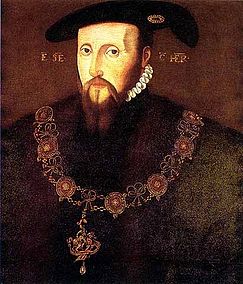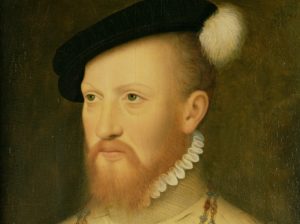The second book in the Seymour Saga is here! (Well, “here” is a relative term: the publication date is not until August, but you can preorder now). As with Jane the Quene, the cover features my protagonist’s portrait, close enough to hint at who he really is.
I have been so excited to release this cover – to share this Edward with the world. Because the fact is that only visitors to Sudeley Castle have ever seen him: somehow the portrait has never made it online (hard to believe, but try googling images). And yet it is the perfect image for the Edward of my book – who is most certainly not the guy that Imperial Ambassador Van Der Delft described in 1547 as “looked down on by everybody as a dry, sour, opinionated man.” Well, okay, perhaps he’s a little opinionated, perhaps a little dry…but that’s just his exterior: the Edward who rises through Henry’s crazy years is an intense, tormented soul. As the book description suggests, this was almost inevitable:
After the tragic romance of Jane the Quene, the second book in The Seymour Saga trilogy, The Path to Somerset, takes a dark turn through an era in which King Henry VIII descends into cynicism, suspicion and fits of madness – and in which mistakes mean death.
Edward’s future is uncertain. Although his sister Jane bore Henry the son he’d sought for twenty years, when she died in childbirth, Henry’s good nature died with her. Now the fiercely ambitious Edward must carve a difficult path through Henry’s shifting principles and wives. Challenged at every turn by his nemesis, Bishop Stephen Gardiner, Edward must embrace ruthlessness in order to safeguard not only his own future but England’s as well.
This is the account of Henry’s tumultuous reign, as seen through the eyes of two opponents whose fierce disagreements over religion and common decency fuel epic struggles for the soul of the nation. And for power.
Can you feel it now?
Before I found this portrait for my cover, I was a bit stuck. I had two choices: the tired older Edward of the “English School” portrait, or the younger one attributed to Holbein who might have been the basis for the “dry, sour, opinionated” remark. My choice then was the Holbein, because when you zoom in on the face things change and you see resolute and strong instead of sneering – you can even get a hint of his “tormented witness to history” side. It was the same thing with Jane (that was Holbein’s genius).


Then last year my wonderful husband brought me to England. It was a short trip but we managed to squeeze in a day for Sudeley Castle. That was where Katherine Parr lived with Thomas Seymour, where she gave birth to her daughter, where she died (fun fact: that makes them the only private castle to have a queen buried in their grounds). I was dying to go – the final book in the Seymour Saga series features Tom Seymour’s betrayal of Edward VI and I wanted to soak up all the atmosphere I could.
So there we were walking through their exhibit section, enjoying things like original letters from Katherine and others, a lace canopy said to have been worked on by Anne Boleyn for Elizabeth’s christening, and other radically cool stuff, when I turned a corner and saw the portrait hanging there. I knew from the doorway that it was Edward.
The painting is said to be by Antonio Moro – the guy whose “compelling realism” gave us the Queen Mary I we know so well – and it really does have that feel. Admittedly, I started out a little suspect about the attribution since the portrait is not included in lists of Moro’s works (maybe this will change that!) and since the broad strokes of his biography don’t fully lend themselves to the possibility: it is well known that Moro came to England to paint Mary, but that didn’t happen until around 1554 – two years after Edward was executed. Still, I believe: I can absolutely point to two ways that Edward could have sat for the artist. First, Moro’s earliest paintings were dated 1538-1544, and they are in the Palais de Beaux-Arts de Lille, not far from where Edward spent time in France during that period. Too (and more likely), Tom Seymour was sent to the Netherlands (where Moro grew up) to keep him away from Katherine Parr during the last royal marriage. Tom returned to England just as Henry was dying and Edward was seizing power – Moro may have come with him then, in which case of course he was at Sudeley…
But no matter the artist, it is the face that is important to me, the face that goes with my story. I hope you love the face I found. I hope you love the story I wrote!



Lovely description of how you found the “right” cover — and the comparisons make your choice so clear. Hope you have all the copyright aspects investigated and settled.
Thank you! I do indeed have the rights I need – that was so important to me!
Congratulations!!! I am looking forward to meeting your Somerset :-).
Thank you, Beth!!